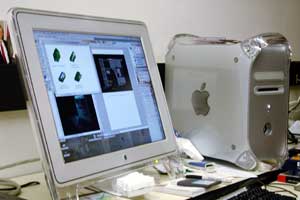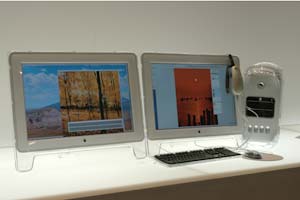Not all monitors are the same.
Those colorful birds featured in years of ViewSonic monitor ads must have left an imprint in my sub-consciousness. ViewSonic monitors often win good reviews, and even the average reviews tend to rate ViewSonic as good, so I figured it was worth getting one, a 20G. I liked it so I got another, a PT 810. When it was time to get a large monitor for the FLAAR office in Germany ViewSonic was a natural choice. I settled on a 21 PS since this had a reasonable price (costs of computer equipment in Europe are normally inflated).
Currently FLAAR has about nine ViewSonic monitors.
With large format digital images it becomes necessary to have dual monitors. The rollouts created by the Better Light are of such high quality that they really need their own monitor to appreciate them. A second monitor is needed as a parking place for icons and reference material.
People in the Macintosh world have long been accustomed to multiple monitors. Jim Robinson, who is the artistic designer behind the BCC+FLAAR Web sites at the beginning, has three monitors. The FLAAR office has two monitors on the main Macintosh machine that creates all the scans for our Web sites.
If a single rollout will fill one entire monitor, think of the demand placed upon the system by a panorama the quality of 4x5 format. These photographs can be enlarged to 3-feet high by 7 feet long with ease. It will take two monitors just to display 90-degrees of the full 360-degree picture.
When people begin going for dual monitors, lots of these will be ViewSonic. In the meantime, since this present generation of Apple PowerBook will accept only one monitor, I at least want this one external monitor to be relatively ample size, unless I get tempted by the ultra-wide monitors that I have seen reviews of; I believe they are Sony. But ViewSonic has a 29" monitor. Now here is the perfect sized screen for viewing a rollout image if you are limited to just one monitor. Unfortunately don’t have one.
Multiple monitors is one of the few features of the Mac world which has not really been readily available to the PC world. But that was all changed when the new versions of the various Windows operating systems become available recently. Supposedly the new Windows will support up to eight monitors.
Soon museums, art historians, archaeologists, architects, architectural historians, will catch up with desktop publishing people who already have dual monitors. Digital images as large and magnificent as those produced by the Better Light or Cruse scanners will encourage this switch to dual monitors.
So today (2003) FLAAR is initiating a long range process to decide which monitors it should recommend for the over 250,000 readers of this digital-photography.org web site (that’s the annual readership, generating over 9,000,000 (nine million) hits and almost a million page views.
Barco used to be the popular monitor for high end graphics. It was replaced by the much cheaper LaCie. In the meantime Nec-Mitsubishi has come out with its SpectraView. Sony now offers the Sony Artisan Color Reference Monitor, GDM-C520K.
 |
 |
| Cinema Display at FLAAR facilities. | Dual Cinema Display at Seybold tradeshow 02. They look stunning when new, but fall apart rapidly. |
The monitors we know more about are from Totoku, provided from US Electronics. Contact is Madhu M. Reddy, phone at (952) 285-5720, or by e-mail monitors@usElectronicsInc.com. We have several Totoku monitors in our facility. I personally like them better than some of the ViewSonic monitors we used to have (too much flicker from the ViewSonic). We can document that Totoku monitors have less flicker than ViewSonic since we have both: we stopped buying ViewSonic monitors after we experienced Tokoku monitors.
Last updated Jan. 10, 2002.
Previously updated Feb. 25, 1999; links added July 10, 1999.